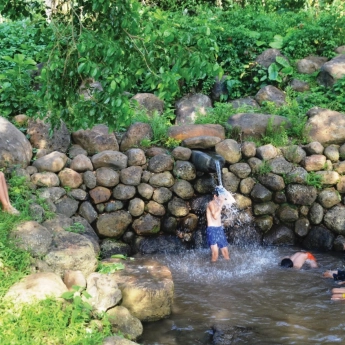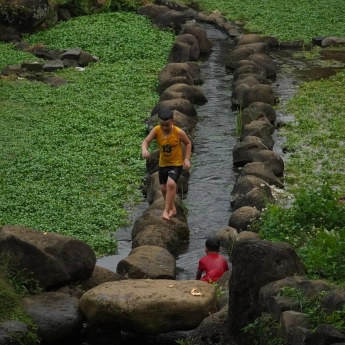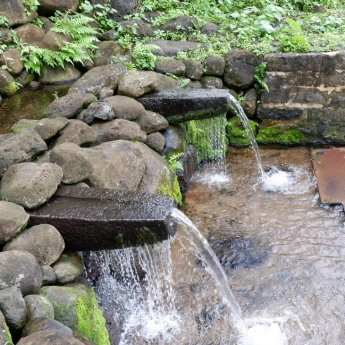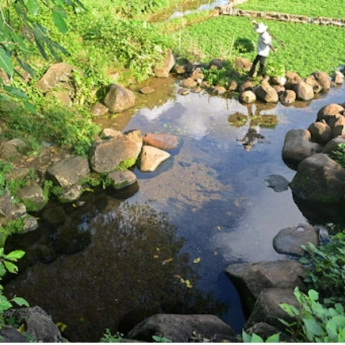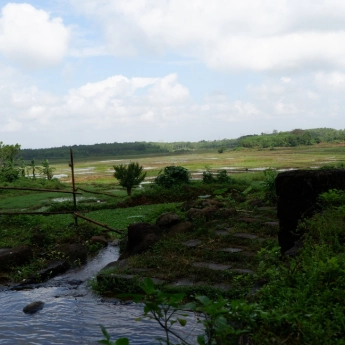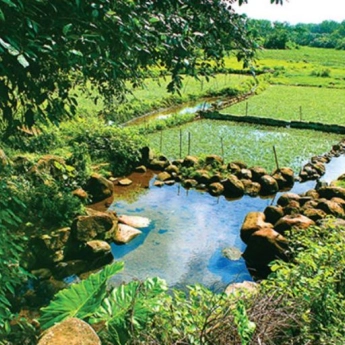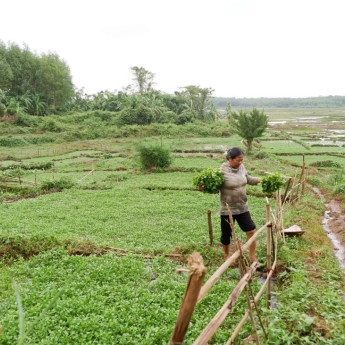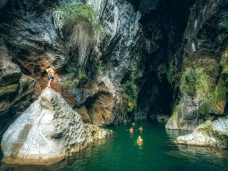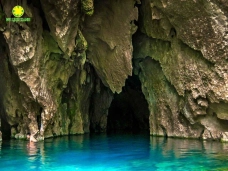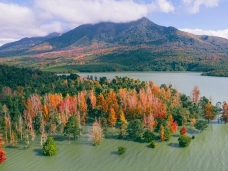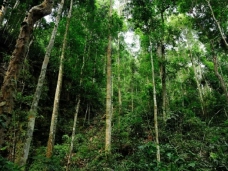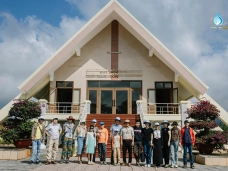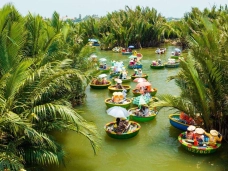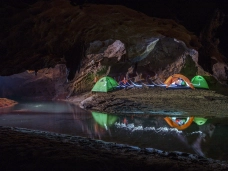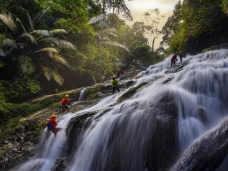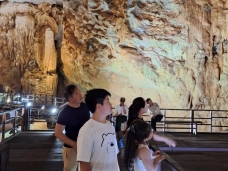Experience Cham Ancient Wells in Gio An – 1,500-Year-Old Water Heritage of Quang Tri
05-09-2025 11:08
Main contents
Location
Highlight Image
Amid the sunny and windy midlands of Quang Tri lies a little-known yet extraordinary “living water museum” that has survived for thousands of years – the ancient Cham wells of Gio An. More than just a source of water, these wells embody the wisdom of indigenous engineering and the remarkable harmony between humans and nature.
Even today, their cool, crystal-clear streams flow endlessly, nourishing lush green watercress fields and sustaining the lifeline of local communities. A visit to Gio An is not only a chance to admire a fascinating ancient irrigation system but also an opportunity to touch the legacy of Cham culture, savor the unique taste of local specialties, and listen to the timeless story of a heritage that has endured across centuries.
Where Are the Ancient Cham Wells of Gio An?
The Cham ancient wells of Gio An are located in Gio An Commune, Gio Linh District, Quang Tri Province – just about 15 km from Dong Ha City, a short 30-minute ride by motorbike or car to reach this “thousand-year water flow.” From Dong Hoi (Quang Binh), the distance is around 100 km, and from Hue it is just over 120 km – both convenient stops to combine within any Central Vietnam itinerary.
Nestled among the gentle basalt hills, Gio An still preserves 14 ancient wells scattered across five villages:
-
An Nha: Coi, Duoi, Bung, Trang, Dao
-
An Huong: Gai 1, Gai 2, Nay
-
Hao Son: Tep, Ong, Ba, Gai
-
Long Son: Mang
-
Tan Van: Pheo
Each well has its own name tied to its function or a local legend, together forming a unique “water map” of Gio An village. Here, crystal-clear streams weave through laterite stones, reflecting bamboo groves and nourishing lush fields of watercress – a landscape both simple and sacred, deeply imprinted with Cham heritage that continues to flow into daily life today.
History & Architecture
Few would guess that the clear wells in Gio An date back 1,500–2,000 years. Some sources even suggest that the system may have originated as far back as 5,000 years, tied to the earliest Cham settlements in Central Vietnam. What is certain is that these are not ordinary wells but one of Vietnam’s rare ancient irrigation systems.
Unlike typical vertical wells, the Cham people ingeniously tapped natural water veins at the basalt foothills. They built laterite embankments to form settling basins, then channeled the water through tightly stacked round stones, creating narrow flows. This method allowed water to run gently year-round – cool in summer, warm in winter – and, most remarkably, never dry up even under the scorching Central sun.
The Gio An wells are thus regarded as a living open-air hydraulic museum. Some are simple domestic wells, while others form complex systems with settling basins, channels, and reservoirs – all perfectly adapted to the midland terrain. Thanks to this, locals had not only a stable source of drinking and household water but also fertile grounds for agriculture, especially the delicate watercress that thrives only in clean, cool streams.
Over millennia, the system has continued to function, a living testament to indigenous wisdom and harmony with nature. Its value has been officially recognized:
-
2001: The Gio An ancient wells were designated a National Historical and Cultural Site.
-
2019: Quang Tri authorities proposed the site for recognition as a Special National Monument, affirming its exceptional cultural and historical significance.
Standing by the laterite embankments, listening to the endless murmuring water, you feel connected to the ancient Cham hands that crafted this system. This is not merely a relic but a living water heritage that still nourishes both the land and people of Gio An.
Cultural & Spiritual Significance
The Gio An wells are more than an irrigation system – they are the very heart of village life. For centuries, the wells have supplied fresh water, nourished green watercress fields, and served as communal gathering places. They are where villagers fetch water, share stories, and where children play – weaving bonds that hold the community together.
In local belief, each well has a soul. Villagers call them the “emerald eyes” of the land, home to water spirits who bring life and prosperity. Maintaining and cleaning the wells is not just routine labor but also a spiritual act of gratitude to ancestors and nature.
Many folk tales are tied to the wells. One legend tells of a Cham princess who, during a drought, struck the ground with her staff, releasing the first spring for the village. Another story recalls a pioneering couple who, after their passing, were honored with a well built in their memory. Though unwritten in official history, these tales live on in community memory, affirming the wells as sacred symbols of gratitude and resilience.
As locals often say: “Protecting the well is protecting the village.” This simple phrase captures the philosophy of generations: safeguarding the wells means safeguarding life, memory, and the very soul of Gio An.
Visitor Experience
A trip to Gio An is not about visiting a “static relic” – it is about touching a living flow of history.
You can stroll along quiet village paths, unexpectedly coming across mossy laterite wells nestled under hillsides. Listen to the water trickling through stone channels, dip your hands in the cool stream, and feel the pulse of an ancient aquifer still breathing beneath the land.
What’s more, you can observe the Cham water system in action: settling basins, stone conduits, and neat embankments guiding the flow. Everything appears simple and natural, yet sophisticated in design – a reminder of the Cham people’s ingenuity.
And of course, Gio An delights with its culinary specialty: fresh watercress. This “picky” vegetable grows only in pristine streams. Enjoy a plate of crisp watercress dipped in spicy fish sauce, and you’ll taste the refreshing crunch of the greens mingling with the rich flavors of the Central coast – a rustic but unforgettable pairing.
📌 Best time to visit: late autumn to early spring, when watercress fields cover the hillsides, glowing golden under the sun like a living watercolor painting.
Suggested 1-day itinerary:
-
Morning: Visit Hao Son – An Nha wells, where morning light sparkles on the water’s surface.
-
Noon: Rest by Ong and Ba wells, shaded by trees and filled with children’s laughter – a reminder that wells are also community playgrounds.
-
Afternoon: Head to Mang Well, where water flows into the watercress fields. At sunset, golden light glows on the laterite stones, ending your journey in peace.
Nearby Attractions
A journey to Gio An is even richer when combined with nearby destinations in Quang Tri:
-
Quang Tri Ancient Citadel (15 km): a solemn site of wartime history, where you can walk among tree-lined paths and hear the echo of bells – a moving reminder of peace today.
-
Vinh Moc Tunnels (30 km): an underground village where locals once lived and fought during the war – a powerful testament to resilience and ingenuity.
-
Cua Tung & Cua Viet Beaches (about 1 hour): pristine white sands and turquoise waters, perfect for relaxation after cultural exploration.
-
La Vang Sanctuary (20 km): a major pilgrimage site for Vietnamese Catholics, offering a tranquil blend of sacred architecture and shaded greenery.
✨ Visiting the ancient Cham wells of Gio An is not just a sightseeing trip. It’s a chance to slow down, breathe with the rhythm of the land, taste the freshness of watercress, and listen to stories whispered by flowing streams – a cultural journey woven with history, nature, and community.
Contact Information
📍 Address: 46 Ba Trieu Street, Dong Hoi, Quang Tri, Vietnam
📞 Phone: +84 911 367 789
📧 Email: phongnha.vie@gmail.com
🌐 Website: https://phongnhaviet.com
👉 Register for your tour HERE
Similar destination
09-01-2026
Ruc Mon – Trekking, Cave Adventure
31-12-2025
Survival Valley – Thuy Cung Cave
15-09-2025



